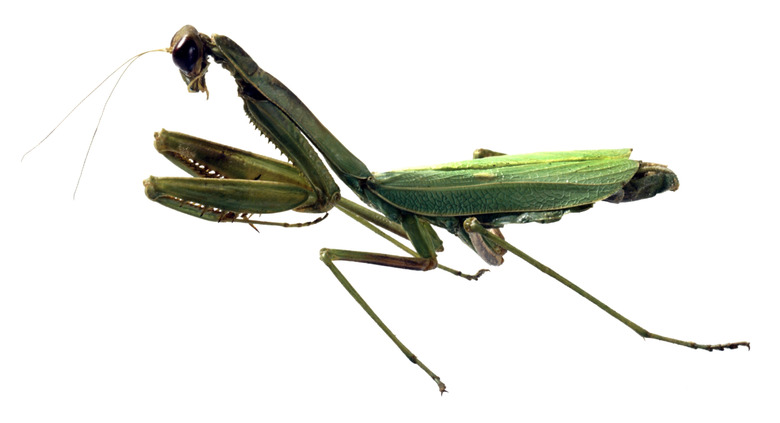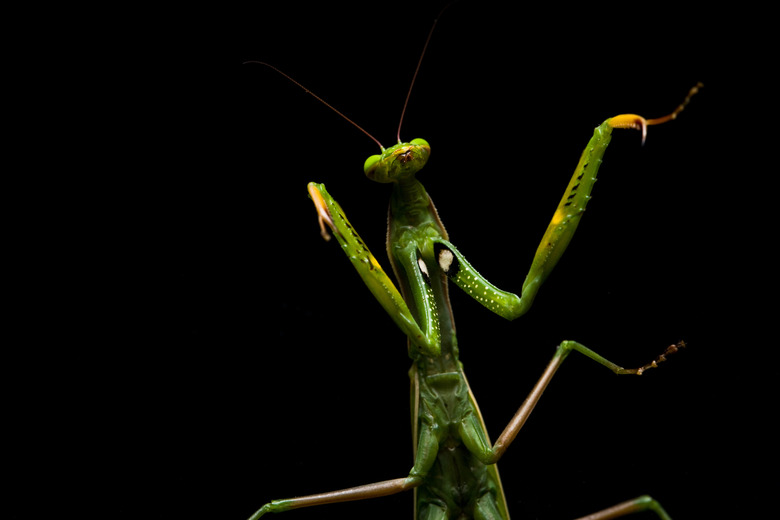Praying Mantis Facts For Kids
The world contains over 1,800 species of praying mantids. The praying mantis scientific name is Mantodea. Many species of mantids have the common name praying mantis. The pictures of praying mantis here look like the classic green European mantis, Mantis religiosa, commonly found in gardens.
Fun Praying Mantis Facts for Kids
Fun Praying Mantis Facts for Kids
While people all traditionally think of unicorns as looking similar to horses, unicorn mantis with spikes on the middle of their head were discovered in the Brazillian rainforest in 2017. Praying mantis get their name from their long front legs that they hold in front of them as if they are in a **praying position.**
Praying mantis are carnivores that use their long front legs to hold their prey while they usually eat them head first! Another fun fact is that they can rotate their heads 180 degrees compared with humans who only have a 130-degree range of movement.
Praying Mantis Sizes
Praying Mantis Sizes
With so many species of praying mantis, there is a wide range of sizes. The smallest praying mantis species (Bolbe pygmaea) is a tiny 0.39 inch (1 cm) long only found in Australia. Another Australian native, the monster mantis (Archimantis monstrosa), reaches up to 3.5 inches (9 cm). The Chinese mantis (Tenodera aridifolia) is also gigantic with an average length of 2.76 inches (7 cm) and a maximum length of 5 inches (12.7 cm).
Praying Mantis Diet
Praying Mantis Diet
Praying mantis have a green or brown coloration to camouflage themselves in the leaves from their unsuspecting prey. Mantis primarily eat smaller insects and small animals such as frogs, birds and lizards. The giant Asian mantis (Hierodula tenuidentata) has also been seen fishing for guppies to eat. Gardeners and farmers generally like having praying mantis among their crops and in their gardens as they eat common plant pests like aphids.
Praying Mantis Hearing
Praying Mantis Hearing
Bats are common predators of praying mantis at night. To escape bats, praying mantis may dive and crash into the ground. Praying mantis can survive the crash with their small, agile bodies but a bat would injure themselves. Bats detect their food by sending out signals of sound and listening to it when it bounces back at them, this is called echolocation. Praying mantis can hear bat sounds with a single ear-like organ in the middle of their chest area, called the thorax in insects.
Praying Mantis Camouflage
Praying Mantis Camouflage
Praying mantis habitats are found all across the world. While many species of mantis are green to blend in with leaves, some have developed particular adaptations to help them blend into their surroundings. Orchid praying mantis (Hymenopus coronatus) have white, yellow or pink bodies to mimic orchid flowers and capture insects. The ground mantis (Eremiaphila braueri krauss) that lives in the stony deserts of Dubai is light brown and a lot shorter and broader than other praying mantis species to help it blend in.
Praying Mantis Breeding
Praying Mantis Breeding
The male sneaks up on the female to mate. If the male is not fast enough at running away, the female may bite his head off. This practice may make some females lay twice as many and healthier eggs with more amino acids. Praying mantis don't just eat the brains of other praying mantis, they have often been recorded catching birds and eating them brain first.
Praying Mantis Vs. Grasshopper
Praying Mantis Vs. Grasshopper
Grasshoppers and praying mantis are both insects, but different species. Unlike praying mantis which are designed for quickly leaping to grab their prey, grasshoppers' hind legs feature large muscles designed to jump away from predators quickly. As carnivores, praying mantis are predators of herbivorous grasshoppers.
References
- National Geographic Kids: Creature Feature: Praying Mantid
- Acoustical Science and Technology: A Steerable Dummy Head That Tracks Three-Dimensional Head Movement: TeleHead
- Praying Mantis: Praying Mantis Scientific Name – Taxonomy and Lower Classifications
- National Geographic: Praying Mantis Looks Like a Flower—And Now We Know Why
- Encyclopaedia Britannica: Grasshopper
- National Geographic: It's Praying Mantis Mating Season: Here's What You Need To Know
- National Geographic: Praying Mantis vs. Grasshopper
- The National Wildlife Federation: How the Praying Mantis Hears
- Dubai Desert Conservation Reserve: Ground Mantis
- Atlas of Living Australia: Bolbe Pygmaea
- Atlas of Living Australia: Archimantis monstrosa
- Animal Diversity Web: Tenodera aridifolia
Cite This Article
MLA
Jerrett, Adrianne. "Praying Mantis Facts For Kids" sciencing.com, https://www.sciencing.com/praying-mantis-kids-8638156/. 18 June 2019.
APA
Jerrett, Adrianne. (2019, June 18). Praying Mantis Facts For Kids. sciencing.com. Retrieved from https://www.sciencing.com/praying-mantis-kids-8638156/
Chicago
Jerrett, Adrianne. Praying Mantis Facts For Kids last modified March 24, 2022. https://www.sciencing.com/praying-mantis-kids-8638156/

